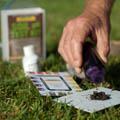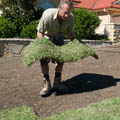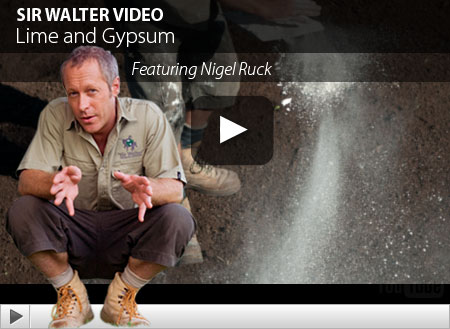 Have you got a threadbare lawn that looks like it hosted a couple of rock festivals … during a flood? Does that area at the back of your house resemble a patchwork quilt of mud and wilted grass stems? Do you fear walking on your lawn in case the bindi turn your feet into pin cushions? Or perhaps you’re building your own home and want a lawn to match your amazing new house.
Have you got a threadbare lawn that looks like it hosted a couple of rock festivals … during a flood? Does that area at the back of your house resemble a patchwork quilt of mud and wilted grass stems? Do you fear walking on your lawn in case the bindi turn your feet into pin cushions? Or perhaps you’re building your own home and want a lawn to match your amazing new house.
Posts tagged as: soil condition
pH Correction Prior to Lawn Installation
 pH – ACID, NEUTRAL AND ALKALINE
pH – ACID, NEUTRAL AND ALKALINE
Your soils’ pH is an important factor, but one that is often overlooked in the eagerness to get your lawn down. pH is measured on a scale from 0 -14 with the lower numbers representing acid soils, the higher numbers alkaline soils and 7 being neutral. READ MORE:
Lawn installation & laying
 Some handy tips from Sir Walter on lawn installation. Let us guide you on laying the perfect Aussie lawn from ground preparation, watering and fertilising to how to lay each piece of Turf, we guide you through the process.
Some handy tips from Sir Walter on lawn installation. Let us guide you on laying the perfect Aussie lawn from ground preparation, watering and fertilising to how to lay each piece of Turf, we guide you through the process.
Lime & Gypsum (video)
Lime and Gypsum
Gypsum, also known as calcium sulphate helps to break down and open up a clay soil allowing water, nutrients, air and lawn roots to penetrate into the soil more easily which is exactly what you want.
Now if you’ve got a clay soil it’s best to incorporate the gypsum into the soil before you spread your turf underlay mix. You can do this with a rotary hoe or you could just use a mattock for small areas.
For an existing lawn use a garden fork, push it in while moving it back and forth. Broadcast the required amount of lime over the area and water it into the soil. Now sometimes you lawn will get damaged from general wear and tear from pets or high traffic and even cold weather. Gypsum will help repair these areas.
Now always read the instructions on the bag buy as a general rule for light clay soils you need to apply 1 kg per square metre and for heavy clay soils you double it to 2 kg per square metre. And remember this too, gypsum is pH neutral, if you want to raise your soils pH you need to apply lime or dolomite.
The Importance of Soil pH for Your Lawn (video)
The Importance of Soil pH for Your Lawn
Sometimes you may find your lawn is not performing very well or not responding to fertiliser and this could be to do with the soils pH.
Now pH is a measure of acidity and alkalinity and Sir Walter lawns like to be in the 6 to 7.5 range for optimum performance. A pH in the right range of 6 to 7.5 is a bit like a plant with its mouth wide open, no food will go to waste here and it will all be eaten by the plant.
Adjusting the pH is easier on loamy and sandy soils than on heavy clays. If your soil is a sandy loam and you need to raise the soil pH by one unit add the equivalent of 150g of liming material per square metre. An adult handful is about 100g.
Heavy clay soils will require at least 250g to raise the pH by one unit. A super fine grade of lime works quickest and generally costs around $8 a bag.
For an established lawn, which may be lacking magnesium, mix 50/50 lime and dolomite as the liming material to get the right balance of calcium and magnesium. Dolomite is only available in one grade and costs around $8 a bag.
After applying lime or dolomite make sure you water them well so that it moves into the soil. Testing the soil’s pH may seem like some mad scientific operation but it couldn’t be simpler with one of the soil pH test kits. All you have to do is follow the instructions and it even tells you how to make the changes.
You can get all the lawn care products you will need here at our online Lawnstore.
Loving your Lawn – Australian Lawn Care Book
 Loving your lawn, your guide to the perfect Aussie Lawn is a unique lawn care guide written by Nigel Ruck. This 126 page lawn care guide is packed full of interesting and useful articles and DIY guides to help you achieve the perfect lawn.
Loving your lawn, your guide to the perfect Aussie Lawn is a unique lawn care guide written by Nigel Ruck. This 126 page lawn care guide is packed full of interesting and useful articles and DIY guides to help you achieve the perfect lawn.





